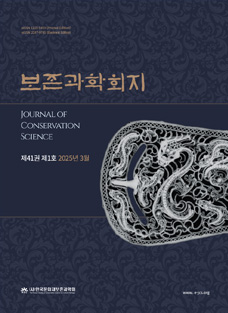Journal of Conservation Science Vol.27 No.1 pp.31-40
동화(진사) 안료의 재료과학적 분석 및 발색특성
Material Analysis and Coloring Characteristics of Korean Traditional Copper-red Pigment (Jinsa)
Jiyoung Kim,Hyun Kyung Cho,Byung Kyu Jun,Nam Chul Cho,Chan Hae Lee
Abstract
Copper-red (Dongwha, Jinsa) is Korean traditional inorganic pigment used for red-coloring on the porcelain surface during Goryeo and Joseon Periods. Trace amounts of copper-red porcelains are handed down because of the technical difficulty of making and coloring of the pigment. It is known that copper ore sources were extensively distributed in Korea according to old literatures and some of them are still producing copper ore at this present. Main types of copper-bearing mineral in Korea are chalcopyrite (CuFeS2) and malachite (Cu2CO3(OH)2), and they are easily collected from the ground surface. This means Korea had geographical and economic geological advantages for supplying raw material of the pigment. These two minerals showed good red-coloring in color test for porcelain pigment. As a coloring element, copper showed micro size less than 5㎛ in diameter in glaze matrix. The dispersion of copper particle is the most decisive factor for red chromaticity of copper-red porcelain, as well as copper content of the pigment.

 E-Submission
E-Submission 
 E-Submission
E-Submission 
![]() Journal Search Engine
Journal Search Engine




 KSC
KSC